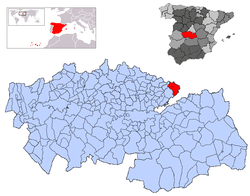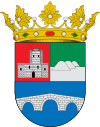Seseña
| Seseña | ||
|---|---|---|
| ||
 | ||
| Coordinates: 40°6′N 3°41′W / 40.100°N 3.683°WCoordinates: 40°6′N 3°41′W / 40.100°N 3.683°W | ||
| Country | Spain | |
| Autonomous community | Castile-La Mancha | |
| Province | Toledo | |
| Municipality | Seseña | |
| Government | ||
| • Mayor | Carlos Velazquez Romo (PP) | |
| Area | ||
| • Total | 72.68 km2 (28.06 sq mi) | |
| Elevation | 598 m (1,962 ft) | |
| Population (2012) | ||
| • Total | 19,109 | |
| • Density | 262.92/km2 (681.0/sq mi) | |
| Demonym(s) | Seseñero/a | |
| Time zone | CET (UTC+1) | |
| • Summer (DST) | CEST (UTC+2) | |
Seseña is a municipality located 35 km south of Madrid in the La Sagra comarca, province of Toledo, Castile-La Mancha, Spain. According to the 2009 census (INE), the municipality had a population of 16,231.
Although in a historically sparsely populated area, Seseña has gained some infamy as a result of controversial new speculative development projects in Vallegrande and El Quiñón during the Spanish property bubble. The municipality is nowadays composed of four sectors that are far away from each other and have no footpath connecting them, as is usual in Spanish towns.
History
The Battle of Seseña was an ill-fated Republican assault on the Nationalist stronghold of Seseña in October 1936 during the Spanish Civil War. The battle is notable for being the first time that tank warfare was seen in the Spanish war and for the use of Molotov cocktails against loyalist Soviet T-26 tanks by Francoist rebel troops.[1][2]
Francisco Hernando
.jpg)
The Residencial Francisco Hernando development was built in the El Quiñón area of Seseña by property developer Onde 2000 during the construction boom of the 2000s (decade) due to the municipality's location within commuting distance of Madrid. It was to be one of the largest such developments in Spain, with an original plan of 13,500 units costing over 9 billion euros to build. However, the massive project raised eyebrows, since utilities such as water and gas lines were not included in the plans (ending up the completed units lacked these fundamentals which rendered them essentially uninhabitable), and also as the project had been approved unusually quickly. It turned out that the authorities had been bribed, and the former local Mayor José Luis Martín was soon arrested, but never brought to trial.[3][4]
Following scandal and the economic crisis related to the Spanish property bubble, the developer ran into trouble sustaining demand and financing for the project. By mid-2008 fewer than 3000 of the completed apartments had been sold and fewer than a third of the sold apartments were occupied, leaving the development a "ghost town" reminder of Spain's economic woes.[5][6][7]
The developer, Francisco Hernando, was never criminally charged with wrongdoing and has moved his business to Equatorial Guinea, a former Spanish Colony in Central Africa.[4]
References
- ↑ History of the Molotov cocktail
- ↑ Thomas, Hugh (1994). The Spanish Civil War. Simon & Schuster, p. 468. ISBN 0-671-75876-4
- ↑ "Meltdown:Secret History of the Global Financial Collapse", Canadian CBC Investigative Television series, 2008.
- 1 2 Alfonso Daniels (2009-02-19). "Property in Spain: Castles in the sand". The Telegraph. United Kingdom: [Telegraph Media Group]. Archived from the original on 2009-02-20. Retrieved 2012-07-09.
In Seseña they claim Hernando persuaded the former mayor José Luis Martín to approve his development six years ago, reclassifying nearly 200 hectares of land from farm to urban usage, while ignoring reports from the regional authorities.... Last July (2008) the public prosecutor’s office formally accused Martín of lying after telling the local assembly that the reports received from the authorities were 'favourable’ and that an environmental impact study had been received (this was not the case), prompting the assembly to approve the project. More damningly, there have also been questions about thousands of pounds the former mayor allegedly pocketed during that same period, an amount Martín claims to have won on the lottery. Hernando says maybe he did win the lottery, and denies having offered any bribes, pointing to the fact that the prosecutor’s office decided not to investigate him. A senior member of the prosecutor’s office confirmed to me on condition of anonymity that Hernando is not under investigation but that the judge will now have to figure out where Martín’s money came from. Few believe that this will happen given that Spain’s regional courts have fewer resources to investigate alleged crimes than those available to the prosecutor.... Only as I am about to leave does he tell me that he has decided to leave Spain, tired of its bureaucracy and of waiting for the economy to improve, and will move to Equatorial Guinea.... The purpose is to build 38,000 homes starting at the end of February, as well as construction plants and even football stadiums to host the 2012 African Cup of Nations, which Equatorial Guinea is hosting with its neighbour Gabon.
. - ↑ "From boom town to ghost town", BBC News, 2008-08-27
- ↑ "How vulnerable is the Spanish economy?", BBC News, 2010-07-21
- ↑ "Seseña, phantom city in crisis", photo essay from article, "Face à la crise, Zapatero a-t-il tout faux?" by Ludovic Lamant, French language Magazine "Le Journal" 2009-12-21.
| Wikimedia Commons has media related to Seseña. |
